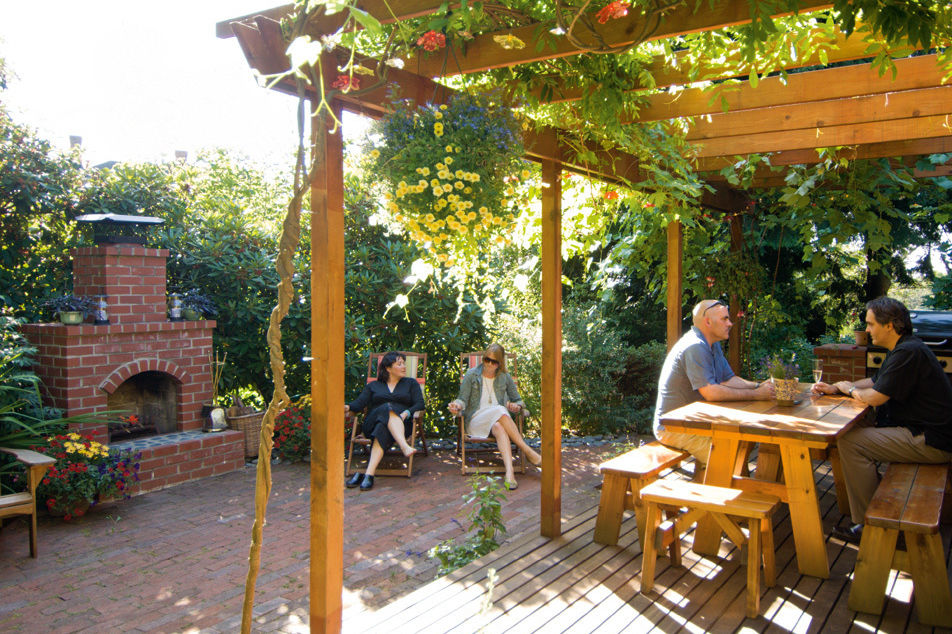Our Feathered Friends
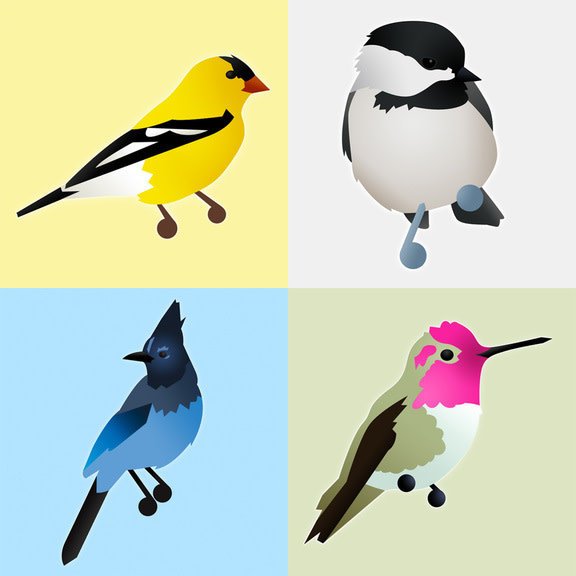
American goldfinch, chickadee, Stellar’s jay and Anna’s hummingbird – all common in various parts of the Portland area in winter
Just up on the Portland Monthly website – a piece I wrote about winter birds – Winged Wonders. I love Garrett’s stylish illustrations of our native bird species. Make sure you click on the slide show, as you’ll find pictured there eight lovely wild birds commonly seen in the Portland metro area in winter, along with information about their native habitats, plants they associate with, and their preferred food sources. These are valuable things to know about if want to entice these lively creatures into your garden.
Many people who feed birds wonder about the politics of feeding wild birds. Is it really good for them to be fed at feeders instead of foraging for their own wild foods? After all, we’re told not to feed ducks at Laurelhurst pond and seagulls at the beach. How do we know which birds to feed and when?
I suppose the rule would be: if you want to butt in to birds’ lives by feeding them, feed them what they would naturally eat. Larger birds such as ducks, geese, crows and seagulls can become a nuisance in parks and urban areas when attracted to the chunks of stale bread people toss them. Bread is also not a natural, nourishing food choice for wild birds. So this practice is not recommended.
Bird feeders stocked with appropriate seed or suet are perfectly good, though: "wild birds don’t need feeders; they need native food sources and habitat," says Karen Munday at the Audubon Society of Portland. "The main benefit of feeders is that they allow people to see wild birds up close. And," she adds, "hopefully that inspires people to protect crucial wild bird habitat in the long run."
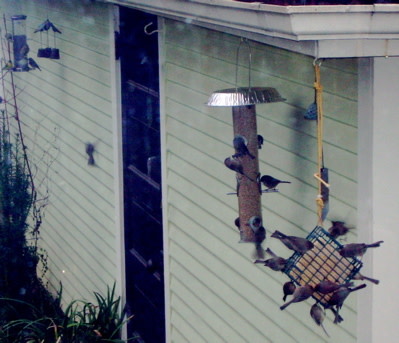
Bushtits (foreground) at suet feeder and sunflower hearts tube feeder; gold finches (back) at thistle feeder
So by all means, set up feeders that are appropriate to the birds you want to attract. Just remember that feeders aren’t the whole story – habitat is the crucial piece of the puzzle for wild birds. And while you shouldn’t worry too much about it, it is worth maintaining feeders during extreme winter weather – for although wild birds are resourceful, they are also creatures of habit, and prolonged frigid temperatures can stretch their resources. Meanwhile, start working on a sustainable plan to create a haven-like habitat for wild birds in your garden.
ATTRACT BIRDS TO YOUR GARDEN – NATURALLY
If you live adjacent to a park, forest or body of water, you probably need no tips on attracting wild birds to your garden – birds surround you. But should you not have forest, open fields, streams, ponds or other wild bird-attracting features around, you may need to work on it a bit. To that end, here are a few basic bird requirements:
Natural food sources Trees, shrubs and herbs that supply fruit, berries, nuts, flower nectar and insect populations that are edible to birds. Different plants attract different sets of birds. Native plants are preferable but many non-invasive ornamentals are also rich sources of food.
Water Water can range from a pond or stream to a simple, 1-inch deep pan of water that is kept clean and fresh. Running water, still water, streams, lakes and ocean each attract different species. You may consider investing in a bird bath heater. But why make life easy when you can run out every hour or two during sub-freezing spells to pour boiling water over your bird baths?
Shelter Depending on the bird, ideal shelter could include gravel or rocky areas, brush piles, hedgerows and shrubby thickets, fields of tall grass, weed patches, tall evergreen trees or tree snags. Another important element of shelter includes safety from non-native predators – and that means keeping domestic cats indoors. If that is not possible, at least keep them indoors during spring nesting season.
DIVERSITY IS KEY
Everything revolves around habitat – and plant – diversity. Monocultures of grass or one species of plant don’t make for good bird habitat, whether it’s a vast sea of lawn or a massive hedge of English laurel. A monoculture of invasive species like English ivy, Portuguese laurel or garlic mustard is even less hospitable, as invasive plants smother native plant habitat that did once support wildlife.
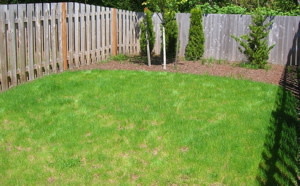
Habitat… waiting to happen

Nectar and pollen diversity, as well as plants ranging from ground level to tree height. I bet there are a few tasty insects in there, too…
Not only species-diverse, but multi-layered plantings are best, with a tree canopy, shrub and herb under-story and ground-cover plants, as well as some bare soil for dust baths and grubbing around for insects. Tree canopies, wooded forest floor, brushy thickets, open areas and brush piles provide plenty of options for birds to feed, nest – and flit from one place to another to evade predators. And what’s good for the birds is good for the bees… and butterflies… and other creatures that comprise healthy, diverse habitat.
GETTING STARTED
Creating hospitable bird habitat is an ongoing process, not something you can do overnight. Start by setting up a bird feeder stocked with appropriate feed in a safe place. Soon, you’ll build a relationship with your local song bird population and begin identifying some of your avian visitors. You’ll notice which birds eat which feed – and what plants or areas of your garden serve as food or shelter for which birds. By observing the charming and complex behavior of wild birds in action, you will discover great delight during the cold, dark months of winter. The next step, naturally, is to seek out the plants and build the habitat that will sustain them in the future.
When I first began feeding winter birds, I worried that I was artificially luring them to stay in an otherwise inhospitable environment. Says the Audubon Society’s Karen Munday, “Birds come to Portland or stay in the area in the winter because of our mild, hospitable climate with good habitat and suitable natural food sources in the region – not because of an individual person’s bird feeder." In fact, most birds require a varied diet composed of seeds, fruit and insects. The importance of a varied diet is especially true for hummingbirds. “Hummingbirds can’t live on sugar water feeders alone: it simply provides them with an energy boost, the way a sugary candy bar does for a person. Hummingbirds need protein, minerals and vitamins supplied by insects, nectar in flowers, and other natural sources.
And since we live in an imperfect world, it must be said that there are some drawbacks associated with feeders. “Feeders artificially gather many birds into one place, which can lead to disease,” says Munday. “Birds fly to the feeder perch, eat, and poop – thereby transmitting any diseases there may be.” What to do? Scrub out feeders once per week with soapy water and then a solution of one part bleach to ten parts water. Allow it to dry completely before adding a one-week supply of fresh bird feed. The same goes for hummingbird feeders: every 4-5 days, wash and dry the feeder before setting it out again with about 4-5 days’ worth of sugar water. Suet should only be used during the cold months – or only set out enough to last a day. Rancid or melting suet is both unhealthy for birds and icky to clean up.
So feeders allow us to see and relate to birds and that is a wonderful thing. But still, natural food sources are best for birds. The Audubon Society encourages native plants as the optimal food sources for native insects and native birds, but there are non-native ornamentals that can be excellent sources of food and habitat.
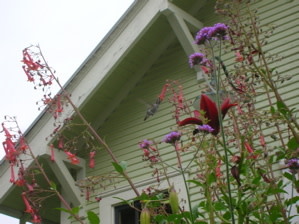
It’s easy to keep hummers supplied with natural nectar sources in summer. During freezing winter weather, it can be a challenge!
There are several sources of good native plant lists and other resources for attracting and supporting native wildlife:
East Multnomah Soil Water and Conservation District
City of Portland Native Plant List
Metro
Xerces Society (What’s good for bees, butterflies and pollinators is good for birds)
- Buy bird supplies:
Backyard Bird Shop
The Audubon Society



